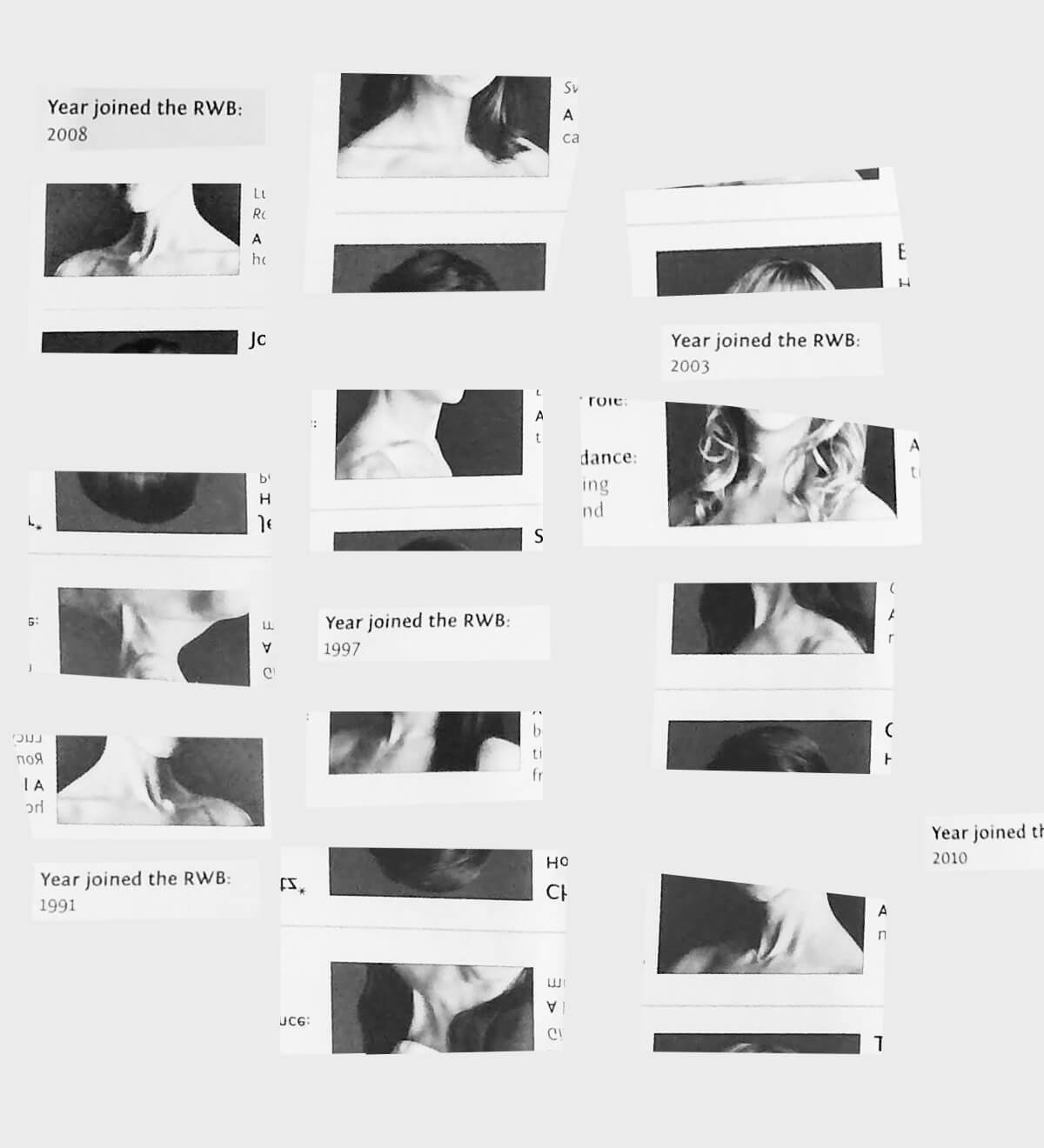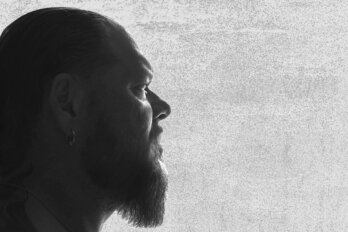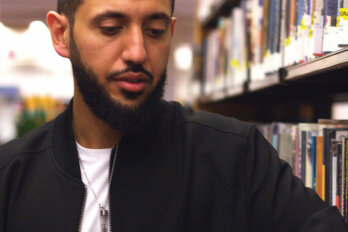I was accepted into the professional division of the Royal Winnipeg Ballet School in 1988, at age thirteen. My parents, who had just divorced, couldn’t afford the cost of both tuition and boarding. So I pleaded and, eventually, my mother agreed to move with me from Lethbridge to Winnipeg. Upon arrival, I immediately transitioned from a fairly normal teenage schedule to a structured life of technical demand and repetition.
Six days a week, eleven months a year, for four years, I entered the dance studio wearing a black leotard, light-pink tights, and ballet shoes, my hair pulled back into a regulation bun. My fellow students and I always started at the barre, stomachs pulled in, shoulders down. Our legs were turned out from the hip through to the ankle, and our feet formed a straight line. This position alone took years to perfect. From there, we began a precise, controlled series of exercises designed to develop strength, flexibility, balance, stamina, and coordination. We were constantly reminded that this training was meant for a future audience—one that shouldn’t see us sweat or breathe. At the end of every class, we bowed in humility and appreciation for the teacher at the front of the classroom.
Over the course of my four years at the school, as everyone who entered the professional division did, I became accustomed to the presence of Bruce Monk. His role was unique: he served as both teacher and photographer. He and his camera appeared regularly in classrooms, in rehearsals, and backstage during performances. The school was highly competitive, and dancers were dismissed every year based on their abilities and progress. As a teacher, Monk had input into who was dismissed. Sometimes, he offered those who were departing a studio session in his apartment to create the photographs they would need to audition elsewhere. By the time any dancer was alone with him, she had been trained to view her body as an artistic object—and to follow his demands without question.
Some former students say that, over the course of more than three decades, Monk manipulated them into taking off their clothing while he photographed them—sometimes nude, other times seminude. Some may have gone to him with the intention of posing nude, and those who did so as adults had every right to make that decision. But many had no idea what would happen when they were alone in his studio. Monk’s deception was captured in his photographs, which he exhibited and sold, and some of which can still be found online today.
Now, I am part of a class-action lawsuit against Monk and the Royal Winnipeg Ballet (RWB), brought forward on behalf of approximately seventy former students, that accuses Monk of using his position of power to prey on young women. (Through a legal representative, Monk refused to comment for this story except to say that the allegations are “not true.” A statement of defence filed on his behalf also denies all allegations.) But, despite our collective efforts over the past seven years—including a national-magazine cover story about our accusations and a police investigation—Monk continues to work, and many of his photos remain online. Criminal charges have not been laid against him. There has been no loud public outrage about his actions. At best, our lawyer says, the class-action suit might result in the RWB paying damages to those who were victimized. It could take years, and it will be the most benign of punishments. (The RWB’s legal team did not respond to requests for comment, but their statement of defence also denies all allegations.)
I have come to believe that the public’s perception of ballet dancers was taken advantage of to suit Monk’s desires, and it continues to undermine the women who have come forward against him over the decades. As students, we were trained to view our bodies as artistic material. Because ballet injuries are common, we were taught to detach from pain—to exude quiet grace under even the most gruelling circumstances. Many of us also suffered emotional harm. (A recent study of professional ballet dancers in Canada found that “the constant comparison, criticism, and correction . . . resulted in feelings of shame, humiliation, and emotional distress.”) Stripped of individuality and autonomous inclination, we were transformed into mechanical devices, and our obedience was used against us.
I hoped our cause would be supported by the growth of the #MeToo movement. But #MeToo is largely defined as a movement against sexual harassment and sexual violence, and it seems to me that, as dancers who were “merely” photographed, we don’t fit the criteria. “Art” is often used as an excuse for poor behaviour: a photo of a young woman sitting naked with her legs spread is less likely to be considered pornography when the perpetrator uses black-and-white film and a platinum printing process. In my experience, Monk’s photographs are treated by some as part of the agreement we made as performers—a choice most of us made as children—to have our bodies used and put on display. But this isn’t what I agreed to or wanted.
Acknowledgement of abuse against women is always evolving: it wasn’t all that long ago, for example, that marital rape was legal. What frustrates me is that forced nudity is a well-documented form of abuse, regardless of gender, age, or whether it was meant to be explicitly sexual. The Supreme Court of Canada declared strip searches “inherently humiliating and degrading” eighteen years ago. Nude photography is a situation where informed consent is vital, and it should never involve the power dynamic Monk’s students faced.
So I wonder what differentiates the former students of the Royal Winnipeg Ballet School from other women who have come forward about abuse. I know, from speaking with them and reading documents pertaining to the lawsuit, how difficult it was for many alumni to admit what had happened to them. I know the shame Monk’s actions caused, the persistent nightmares, the feelings of betrayal, fear, and helplessness. I know that those photo sessions resulted in women experiencing self-loathing and suicidal ideation. I want each and every one of those women to understand that what happened was wrong and that it was not their fault. I want all women to be in control of both their bodies and photographs of their bodies—to feel supported by society and to know that, in coming forward about any type of abuse, they are helping to prevent it from happening to others. But, as it stands, because this story is still relatively unknown and those culpable have gone unpunished, it could easily happen again.
Many girls were alone with Monk when they posed for him. I was an exception. When he photographed me in his apartment, in 1992, somewhere around my seventeenth birthday, I brought my mother with me. My chronic injuries, which had begun a year after I joined the program, had worsened to the point when doctors ordered me to stop dancing and the school kicked me out.
It was a stressful time for my mother and me. My exit meetings at the school, prior to expulsion, were confusing and devastating. Leaving ballet school meant I would no longer be doing what I loved and I would lose my peer group. It was also during this time that my mother found out she had breast cancer. She needed a mastectomy, something that I couldn’t wrap my head around: I didn’t understand what it meant for her to lose that part of her body. We were both broken and struggling with loss.
So I hadn’t told my mother why I’d asked her to come with me to the photoshoot. Monk was doing us a favour. I was determined to continue despite my injuries, and we couldn’t afford to pay a professional for the photos I would need to audition elsewhere. Around that time, I had heard rumours that he sometimes asked girls to take their tops off. I figured my mother’s presence would secure my safety. But, during the shoot, Monk placed her behind the backdrop he was using, where she couldn’t see me and would be distracted by books and magazines. He didn’t seem to be hindered by a parent in the room.
Some of the former students who are now accusing Monk had similar experiences to mine. His ruse, the one I am familiar with, went like this: knowing that, as ballet students, we were familiar with headshots that showcased a bare neckline, he would ask that our bodysuit straps be pulled down, tucked under our arms and out of frame. At first, he allowed me discretion, letting me turn my back to him while I adjusted my leotard. Then, he continued telling me that what I was wearing was in the frame, obstructing the line he was creating. Several adjustments later, as my bodysuit inched closer to my waist, he let me use my arms to cover myself. Suddenly, there was a shift.
“Drop your arms, Serena,” I remember him telling me. Over and over he said it. The unexpected change in tone was terrifying. I did not drop my arms. They were all that separated his camera from my naked upper body. Right then, my mother stood up and walked over, and the photoshoot abruptly ended. He later asked me to return, alone, for a “body study.” I never posed for him again. I danced for three more years while working through my injuries, finding a place at Montreal’s École supérieure de ballet du Québec. For my audition, I used one of the photos Bruce had taken of me, one in which I was fully clothed, in tights, a bodysuit, and pointe shoes. To this day, it is the only photo I have of myself dancing.
One day in the mid-2000s, long after I’d left ballet for good, I saw someone who looked like Monk walk into the photography supply store where I worked in Vancouver. I was sure it was him, and the fear he’d instilled in me as a teenager rushed back in full force. Buried memories of that photoshoot in his apartment rose to the surface. My departure from the school had left me feeling betrayed and humiliated. Talking about Monk’s behaviour or going to the police didn’t feel like options at the time. He had never managed to expose my body, after all—I hadn’t dropped my arms. The only thing I felt I could provide was corroboration for others who had had similar experiences in his apartment.
Monk emailed me shortly after his appearance at my work. I could no longer ignore that he was out there. I looked him up: he was still teaching, presumably still the school’s photographer. Because my mother had been in the room during my photoshoot, I decided I was uniquely positioned to try to stop him. Online, I found an RWB alumni message board. I decided to leave a post that would catch the attention of those who had gone through what I had with Monk. A former classmate contacted me. She wasn’t ready to act yet. But, in 2012, she agreed to come forward, and we filed two police reports, in our respective cities, detailing our experiences. Those reports launched an investigation into Monk by the Winnipeg Police Service Internet Child Exploitation Unit.
Progress was slow. Eventually, we were told that Canada’s child-pornography laws, which prohibit photography of underage subjects for sexual purposes, only came into effect in 1993; our specific allegations predated the law. By then, we had found more women, through word of mouth, who had experienced what we had. Many said they had been under eighteen when it happened. This made me more hopeful that criminal charges were imminent.
Initially, because he had been selling images online, I thought he would be charged with publishing intimate images without consent. In a handwritten letter to me after I had requested my negatives in 2014, he apologized and said he had destroyed most of them. I remember police telling me this meant destruction of evidence was a possible charge. But no criminal charges were ever laid. No one seemed to consider his actions a serious offence.
This is when things, for me, went from bad to worse. I fell into a depression that no amount of medication or therapy has been able to pierce.
Failed by police, I worked with a reporter who was willing to write a story about what had happened. The article, “Scandal at the Ballet,” was published by Maclean’s in April 2015, with one of the photos Bruce had taken of me, in a bodysuit and ballet shoes, on the cover. I’m seated, leaning forward, with my arms crossed close to my chest. I’m looking into the camera and I’m not smiling. After the article was published, I could feel people recoil from me. My world shrank. Some people, those who understood that what had happened in Winnipeg was wrong, attempted to comfort me: I was brave, they said, and I had done the right thing. The truth is that I hadn’t spoken out from a place of fortitude or bravery. I’d done it thinking that, since I was already at the bottom, I had little to lose.
Shortly after the Maclean’s story appeared online, Monk was fired by the Royal Winnipeg Ballet School. The school claimed it knew nothing of his actions, but it was later reported that some teachers had been alerted to Monk’s inappropriate behaviour in 2013. (In its statement of defence, the RWB says it had no knowledge of “the events and complaints ‘broadly circulated.’”) After Winnipeg, Monk worked with Ballet Victoria. As recently as last year, his photographs of nude women and girls were still available online, and his images even remain in the collection of the National Gallery of Canada. The women who had come forward were incredibly disappointed. I felt awful, heartbroken, angry. We thought the police would do much more. But the public was placated, and the story quickly disappeared from the news cycle.
Many things have happened since the Maclean’s article came out in 2015, but one story of institutional failure has been particularly meaningful for me. In 2018, Larry Nassar, a former doctor for USA Gymnastics and an osteopathic physician at Michigan State University, was sentenced to 175 years in prison for molesting hundreds of girls over a period of more than twenty years. More than 150 women read impact statements at the sentencing hearing.
“Your decision to assault was precise, calculated, manipulated, devious, despicable,” the judge, Rosemarie Aquilina, told Nassar during his sentencing. “You do not deserve to walk outside of a prison ever again.” Afterward, there was sweeping anger, calls for accountability and change. New federal bills were passed, a host of USA Gymnastics and Michigan State authority figures resigned, and new advocacy groups were founded for survivors of sexual violence.
The stories from Nassar’s trial resonated with me deeply. The lack of criminal charges against Monk felt like a personal failure. Monk’s wrongdoings are very different from Nassar’s, and Monk is not accused of the same crimes. But the two men were based in a similar environment, where girls are groomed and trained to obey orders without question. Gymnastics and ballet have a lot in common: both require intense, supervised physical training from a young age. Nassar used manipulation in the form of supposedly therapeutic medical treatments to prey on girls who were embedded in a sport. His role as a trusted physician allowed him to disguise his abuse. Monk, on the other hand, used art to mask his treatment of girls and women who were used to seeing their bodies as vehicles for artistic expression. Ballerinas, even at their best, don’t achieve the fame of Hollywood actors or Olympians. They don’t become household names. They don’t get tied to our national pride. And with that comes vulnerability and isolation.
Since our stories about Monk have started to circulate, people’s responses—support and acknowledgement or, conversely, rejection and ignorance—have had huge power to make me feel more or less broken, more or less afraid, even years later. I track reactions vigilantly. As a residual effect of my experience with Monk, every day I wake with the knowledge that betrayal and humiliation can come at any time, from any person. I never feel safe. I perceive male attention as predatory. I’m suspicious of power at every level, be it a manager at a coffee shop, a teacher, or someone bestowed with wealth or celebrity.
Last September, the Guardian published an article about what happened at the Royal Winnipeg Ballet School. When I read it, I was crushed. “After years of whispers,” its author wrote, “former students began speaking out in 2015.” Another student and I had filed police reports in 2012. Was that not speaking out? It felt as though three years had been erased, and those years had been difficult. In 2014, I had written Bruce a letter instructing him to send me my negatives; it was a demand, not a whisper. After my complaint, the Guardian made a correction.
It’s been nearly seven years since a former classmate and I reported Monk. We didn’t know how hard the fight would be, how many years it would take, or that it would involve journalists and lawyers. As with all trials where women accuse men of misconduct, speaking out prompts accusations of lying for money or attention. Unfortunately, speaking out is all we have. Back when we were students, entrenched in the strict regimen of the RWB, determination and dedication were qualities required of us. Now, we use those same qualities to help us stand up to those we had once bowed to.
Without any criminal charges laid against Monk, I push ahead not just in support of the dozens of women participating in the civil suit, but also for those who have not yet come forward. When over 150 women read impact statements about Nassar, they did so at a sentencing hearing after he had been convicted. My hope is that we will see the same kind of accountability for Monk. Though he may never be found guilty of a crime, I hope that an acknowledgement of his culpability will bring strength and healing to all those who were hurt by him, as well as solidarity and change.




